Domestic Herbivores, the Crucial Trophic Level for Sustainable Agriculture: Avenues for Reconnecting Livestock to Cropping Systems
Abstract
1. Introduction
2. Where Does Soil Fertility to Support Agricultural Production Come From?
- (i)
- An internal cycling in the plant corresponding to translocation of some organic mineral molecules with N, P, K, sulfur (S), and some others involved in plant metabolism from active plant organs (leaves and fine roots) during senescence to perennial storage organs (tap roots, trunks, rhizomes), representing a nutrient reserve for plant regrowth after defoliation and winter or drought damage. Hence, before returning to soil as litter, leaves have recycled at least two thirds of their N and P content [53,54]. Thus, the C/N ratio of mature green leaves of grass species is approximately 12–17, and this ratio increases to 24–33 for leaf litter [55,56]. In this way, perennial vegetation dominates natural plant communities because this internal recycling is very conservative.
- (ii)
- An external recycling through leaf and root litter deposition in soil with the mineralization–immobilization turnover (MIT) of N, P, and other minerals in the rhizosphere, leading to a progressive decoupling of C from N and P and a smoothed restitution of mineral forms of these elements to soil solutions to be either absorbed by plants or reincorporated in new microbe bodies [57,58].
3. Historical Analysis of the Role of Domestic Herbivores in Renewing Soil Fertility in Agricultural Systems
4. The Current Crisis in Industrialized Agriculture and the Need for Recoupling of Livestock and Crop Production
4.1. Ecosystem Services of Grasslands and Forage/Herbivores Associated with Arable Cropping Systems
4.2. Specialized Versus Integrated Crop–Livestock Farming Systems in Europe
- Intensive specialized livestock farming systems are characterized by a high livestock density combined with a large share of imported feed to meet animal nutrition; in these systems, livestock farming is loosely connected to crop farming.
- Specialized stockless cropping systems refer to agro-food systems where crop production based on synthetic fertilizers is much more important in terms of material flow than livestock farming, which contributes only minimally to cropland fertilization.
- Disconnected crop and livestock systems, crop and livestock farming both co-exist but without strong connections in terms of manure used by cropland and local feed products in livestock feeding.
- Mixed crop and livestock systems have a high degree of coupling between crop and livestock farming activities because (i) manure provides a relatively high proportion of cropland soil fertilization, and (ii) local agricultural production provides a high share of animal nutrition. Within this category, grass-based and fodder-based systems can be distinguished according to the dominance of grass from permanent grassland or of fodder produced on arable land in livestock nutrition.
4.3. Some Examples of Soil Fertility Management in Integrated Crop–Livestock Systems in Brazil
4.4. Generalization at Worldwide Level
5. Lessons Learned and Future Efforts
Author Contributions
Funding
Data Availability Statement
Conflicts of Interest
References
- United Nations. Transforming Our World: The 2030 Agenda for Sustainable Development; United Nations: New York, NY, USA, 2015. [Google Scholar]
- Rockström, J.; Steffen, W.; Noone, K.; Persson, A.; Chapin, S.; Lambin, E.F.; Lenton, T.M.; Scheffer, M.; Folke, C.; Schellnhuber, H.J.; et al. A safe operating space for humanity. Nature 2009, 461, 472–475. [Google Scholar] [CrossRef] [PubMed]
- de Vries, W.; Kros, J.; Kroeze, C.; Seitzinger, S.P. Assessing planetary and regional nitrogen boundaries related to food security and adverse environmental impacts. Curr. Opin. Environ. Sustain. 2013, 5, 392–402. [Google Scholar] [CrossRef]
- Smith, P. Delivering food security without increasing pressure on land. Glob. Food Sec. 2013, 2, 18–23. [Google Scholar] [CrossRef]
- Billen, G.; Lassaletta, L.; Garnier, J. A Vast Range of Opportunities for Feeding the World in 2050: Trade-Off between Diet, N Contamination and International Trade. Environ. Res. Lett. 2015, 10, 025001. [Google Scholar] [CrossRef]
- Erb, K.-H.; Lauk, C.; Kastner, T.; Mayer, A.; Theurl, M.C.; Haberl, H. Exploring the biophysical option space for feeding the world without deforestation. Nat. Commun. 2016, 7, 11382. [Google Scholar] [CrossRef] [PubMed]
- Kastner, T.; Rivas, M.J.I.; Koch, W.; Nonhebel, S. Global changes in diets and the consequences for land requirements for food. Proc. Natl. Acad. Sci. USA 2012, 109, 6868–6872. [Google Scholar] [CrossRef]
- Muller, A.; Schader, C.; El-Hage Scialabba, N.; Br€uggemann, J.; Isensee, A.; Erb, K.-H.; Smith, P.; Klocke, P.; Leiber, F.; Stolze, M.; et al. Strategies for feeding the world more sustainably with organic agriculture. Nat. Commun. 2017, 8, 1290. [Google Scholar] [CrossRef]
- Theurl, M.; Lauk, C.; Kalt, G.; Mayer, A.; Kaltenegger, K.; Morais, T.G.; Teixira, R.F.M.; Domingos, T.; Winiwarter, W.; Erb, K.H.; et al. Food systems in a zero-deforestation world: Dietary change is more important than intensification for climate targets in 2050. Sci. Total Environ. 2020, 735, 139353. [Google Scholar] [CrossRef]
- Smith, L.G.; Kirk, G.J.; Jones, P.J.; Williams, A.G. The Greenhouse Gas Impacts of Converting Food Production in England and Wales to Organic Methods. Nat. Commun. 2019, 10, 1–10. [Google Scholar] [CrossRef]
- Connor, D.J. Short Communication. Organic Agriculture Cannot Feed the World. Field Crops Res. 2008, 106, 87–190. [Google Scholar] [CrossRef]
- Fresan, U.; Sabaté, J. Vegetarien diets: Planetary Health and Its Alignment with Human Health. Adv. Nutr. 2019, 10, S380–S388. [Google Scholar] [CrossRef] [PubMed]
- Carvalho, P.C.d.F.; Anghinoni, I.; Moraes, A.; Souza, E.D.; Sulc, R.M.; Lang, C.R.; Flores, J.P.C.; Lopes, M.L.T.; Silva, J.L.S.; Conte, O.; et al. Managing grazing animals to achieve nutrient cycling and soil improvement in no-till integrated systems. Nutr. Cycl. Agroecosyst. 2010, 88, 259–273. [Google Scholar] [CrossRef]
- Bruinsma, J. The Resource Outlook to 2050. In By How Much Do Land, Water and Crop Yields Need to Increase by 2050? Proceedings of the FAO Expert Meeting on How to Feed the World in 2050, Rome, Italy, 24–26 June 2009; FAO: Rome, Italy, 2009; p. 33. [Google Scholar]
- Godfray, H.C.J.; Beddington, J.R.; Crute, I.R.; Haddad, L.; Lawrence, D.; Muir, J.F.; Robinson, R.; Thomas, S.; Toulmin, C. Food security: The Challenge of Feeding 9 Billion People. Science 2010, 327, 812–818. [Google Scholar] [CrossRef] [PubMed]
- Giam, X. Global Biodiversity Loss from Tropical Deforestation. Proc. Natl. Acad. Sci. USA 2017, 114, 5775–5777. [Google Scholar] [CrossRef]
- Cassman, K.G.; Grassini, P.; van Hart, J. Crop Yield Potential, Yield Trends, and Global Food Security in a Changing Climate. In Handbook of Climate Change and Agroecosystems: Impacts, Adaptation, and Mitigation; Rosenzweig, C., Hillel, D., Eds.; Imperial College Press: London, UK, 2010. [Google Scholar] [CrossRef]
- Intergovernmental Panel on Climate Change. In Food Security and Food Production Systems, Proceedings of the in Climate Change 2014—Impacts, Adaptation and Vulnerability: Part A: Global and Sectoral Aspects: Working Group II Contribution to the IPCC Fifth Assessment Report; Cambridge University Press: Cambridge, UK, 2014; pp. 485–534.
- Tittonell, P.A. Farming System Ecology. Towards ecological intensification of world agriculture. In Inaugural Lecture upon Taking up the Position of Chair in Farming Systems Ecology at Wageningen University on 16 May 2013; Wageningen University: Wageningen, The Netherlands, 2013; ISBN 978-94-6173-617-8. [Google Scholar]
- Mwangi, W.; de Figueredo, P.; Criscitelio, M.F. One Heath: Adressing Global Challenges at the Nexus of Human, Animal and Environmental Health. PLoS Pathog. 2016, 12, 1–8. [Google Scholar] [CrossRef]
- Finn, S.; Fallon, L.O. Commentary the Emergence of Environmental Health Literacy—From Its Roots to Its Future Potential. Environ. Health Persp. 2017, 125, 495–501. [Google Scholar] [CrossRef]
- Ekins, P.; Gutpa, J. Perspectives: A Healthy Planet for Healthy People. Glob. Sustain. 2019, 2, 1–9. [Google Scholar] [CrossRef]
- Duru, M.; Therond, O.; Martin, G.; Martin-Clouaire, R.; Magne, M.; Justes, E.; Journet, E.-P.; Aubertot, J.-N.; Savary, S.; Bergez, J.-E.; et al. How to Implement Biodiversity-Based Agriculture to Enhance Ecosystem Services: A Review. Agron. Sustain. Dev. 2015, 35, 1259–1281. [Google Scholar] [CrossRef]
- Therond, O.; Duru, M.; Roger-Estrade, J.; Richard, C. A New Analytical Framework of Farming System and Agriculture Model Diversities: A Review. Agron. Sustain. Dev. 2017, 37, 21. [Google Scholar] [CrossRef]
- Gerber, P.J.; Steinfeld, H.; Henderson, B.; Mottet, A.; Opio, C.; Dijkman, J.; Falcucci, A.; Tempio, G. Tackling Climate Change through Livestock—A Global Assessment of Emissions and Mitigation Opportunities; FAO: Rome, Italy, 2013; Available online: https://www.fao.org/3/a-i3437e.pdf (accessed on 27 April 2018).
- Billen, G.; Thieu, V.; Garnier, J.; Silvestre, A. Modelling the N cascade in regional watersheds: The case study of the Seine, Somme and Scheldt rivers. Agric. Ecosyst. Environ. 2009, 133, 234–246. [Google Scholar] [CrossRef]
- Herrero, M.; Havlík, P.; Valin, H.; Notenbaertb, A.; Rufinob, M.C.; Thorntond, P.K.; Blümmelb, M.; Weissc, F.; Graceb, D.; Obersteiner, M. Biomass use, production, feed efficiencies, and greenhouse gas emissions from global livestock systems. Proc. Natl. Acad. Sci. USA 2013, 110, 20888–20893. [Google Scholar] [CrossRef] [PubMed]
- Duru, M.; Moraine, M.; Therond, O. An Analytical Framework for Structuring Analysis and Design of Sustainable Ruminant Livestock Systems. Anim. Front. 2015, 5, 6–13. [Google Scholar]
- Carrera-Bastos, P.; Fontes, M.; O’Keefe, J.; Lindenberg, S.; Cordain, L. The Western Diet and Lifestyle and Diseases of Civilization. Res. Rep. Clin. Cardiol. 2011, 15, 15–35. [Google Scholar] [CrossRef]
- Sonnenburg, E.D.; Sonnenburg, J.L. The Ancestral and Industrialized Gut Microbiota and Implications for Human Health. Nat. Rev. Microbiol. 2019, 17, 383–390. [Google Scholar] [CrossRef]
- Godfray, H.C.J.; Aveyard, P.; Garnet, T.; Hall, J.W.; Key, T.J.; Lorimer, J.; Pierrehumbert, R.T.; Scarborough, P.; Springmann, M.; Jebb, S.A. Meat Consumption, Health, and the Environment. Science 2018, 361, eaam5324. [Google Scholar] [CrossRef]
- Bellarby, J.; Tirado, R.; Leip, A.; Weiss, F.; Lesschen, J.P.; Smith, P. Livestock Greenhouse Gas Emissions and Mitigation Potential in Europe. Glob. Change Biol. 2013, 19, 3–18. [Google Scholar] [CrossRef]
- Benoit, M.; Mottet, A. Energy Scarcity and Rising Cost: Towards a Paradigm Shift for Livestock. Agricult. Syst. 2023, 205, 103585. [Google Scholar] [CrossRef]
- Steinmetz, L.; Veysset, P.; Benoit, M.; Dumont, B. Ecological Network Analysis to Link Interactions between System Components and Performances in Multispecies Livestock Farms. Agron. Sustain. Dev. 2021, 41, 42. [Google Scholar] [CrossRef]
- Xie, J.; Hu, L.; Tang, J.; Wue, X.; Li, N.; Yuan, Y.; Yang, H.; Zhang, J.; Luo, S.; Chen, X. Ecological Mechanisms Underlying the Sustainability of the Agricultural Heritage Rice–Fish Coculture System. Proc. Natl. Acad. Sci. USA 2011, 108, E1381–E1387. [Google Scholar] [CrossRef]
- Caitlin, A.P.; Eviner, V.T.; Gaudin, A.C.M. Ways Forward for Resilience Research in Agroecosystems. Agric. Syst. 2018, 162, 19–27. [Google Scholar] [CrossRef]
- Provenza, F.D.; Meuret, M.; Gregorini, P. Our Landscape, our Livestock, Ourselves: Restoring Broken Linkages among Plants, Herbivores, and Humans with Diets that Nourish and Satiate. Appetite 2015, 95, 500–519. [Google Scholar] [CrossRef]
- Uhlig, D.; von Blackenburg, F. How Slow Rock Weathering Balances Nutrient Loss During Fast Forest Floor Turnover in Montane, Temperate Forest Ecosystems. Front. Earth Sci. 2019, 7, 159. [Google Scholar] [CrossRef]
- Cleveland, C.C.; Houlton, B.Z.; Smith, W.K.; Marklein, A.R.; Reed, S.C.; Parton, W.; Del Grosso, S.J.; Running, S.W. Patterns of New Versus Recycled Primary Production in the Terrestrial Biosphere. Proc. Natl. Acad. Sci. USA 2013, 110, 12733–12737. [Google Scholar] [CrossRef]
- Vitousek, P.; Chadwick, O.; Matson, P.; Allison, S.; Derry, L.; Kettley, L.; Luers, A.; Mecking, E.; Monastra, V.; Porder, S. Erosion and the Rejuvenation of Weathering-Derived Nutrient Supply in an old Tropical Landscape. Ecosystems 2003, 6, 762–772. [Google Scholar] [CrossRef]
- Frings, P.J.; Buss, L.H. The Central Role of Weathering in the Geosciences. Elements 2019, 15, 229–234. [Google Scholar] [CrossRef]
- Cooke, R.U.; Doornkamp, J.C. Geomorphology in Environmental Management; Clarendon Press: Oxford, UK, 1990; p. 410. [Google Scholar]
- Goudie, A.S.; Viles, H.A. Weathering and the Global Carbon Cycle: Geomorphological Perspectives. Earth Sci. Rev. 2012, 113, 59–71. [Google Scholar] [CrossRef]
- Phillips, J.D.; Turkington, A.V.; Marion, D.A. Weathering and Vegetation Effects in Early Stages of Soil Formation. Catena 2008, 72, 21–28. [Google Scholar] [CrossRef]
- Vázquez, A.; Costoya, M.; Peña, R.M.; García, M.; Herrero, C. A rainwater quality monitoring network: A preliminary study of the composition of rainwater in Galicia (NW Spain). Chemosphere 2003, 51, 375–386. [Google Scholar] [CrossRef] [PubMed]
- Holland, E.A.; Braswell, B.; Sulzman, J.; Lamarque, J.-F. Nitrogen deposition onto the United States and western Europe: Synthesis of observations and models. Ecol. Appl. 2005, 15, 38–45. [Google Scholar] [CrossRef]
- Du, H.; Zuo, X.; Li, S.; Wang, T.; Xue, X. Wind Erosion Changes Induced by Different Grazing Intensities in the Desert Steppe, Northern China. Agric. Ecosyst. Environ. 2019, 274, 1–13. [Google Scholar] [CrossRef]
- Van Langenhove, L.; Verryckt, L.T.; Bréchet, L.; Courtois, E.A.; Stahl, C.; Hofthansi, F.; Bauters, M.; Sardans, J.; Boeckx, P.; Fransen, E.; et al. Atmospheric Deposition of Elements and Its Relevance for Nutrient Budgets of Tropical Forests. Biogeochemistry 2020, 149, 175–193. [Google Scholar] [CrossRef]
- Unkovich, M.; Baldock, J. Measurement of asymbiotic N2 fixation in Australian agriculture. Soil Biol. Biochem. 2008, 40, 2915–2921. [Google Scholar] [CrossRef]
- Galloway, J.N.; Leach, A.M.; Bleeker, A.; Erisman, J.W. A Chronology of Human Understanding of the Nitrogen Cycle. Philos. Trans. R. Soc. B Biol. Sci. 2013, 368, 20130120. [Google Scholar] [CrossRef] [PubMed]
- Vitousek, P.M.; Cassman, K.; Cleveland, C.; Crews, T.; Field, C.B.; Grimm, N.B.; Howarth, R.W.; Marino, R.; Martinelli, L.; Rastetter, E.B.; et al. Towards an ecological understanding of biological nitrogen fixation. Biogeochemistry 2002, 57, 1–45. [Google Scholar] [CrossRef]
- Vitousek, P.M.; Menge, D.N.L.; Reed, S.C.; Cleveland, C.C. Biological Nitrogen Fixation: Rates, Patterns and Ecological Controls in Terrestrial Ecosystems. Philos. Trans. R. Soc. B Biol. Sci. 2013, 368, 20130119. [Google Scholar] [CrossRef] [PubMed]
- Lodge, G.M.; King, K.L.; Harden, S. Effects of pasture treatments on detached pasture litter mass, quality, litter loss, decomposition rates, and residence time in northern New South Wales. Aust. J. Agric. Res. 2006, 57, 1073–1085. [Google Scholar] [CrossRef]
- Lemaire, G.; Culleton, N. Effects of nitrogen applied after the last cut in autumn on a tall fescue sward. II. Uptake and recycling on nitrogen in the sward during winter. Agronomy 1989, 9, 241–249. [Google Scholar] [CrossRef]
- Sanaullah, A.; Chabbi, A.; Lemaire, G.; Charrier, X.; Rumpel, C. How Does Plant Leaf Senescence of Grassland Species Influence Decomposition Kinetics and Litter Compounds Dynamics? Nutr. Cycl. Agroecosyst. 2010, 88, 159–171. [Google Scholar] [CrossRef]
- Li, R.; Zhang, Y.; Yu, D.; Wang, Y.; Zhao, X.; Zhang, R.; Zhang, W.; Wang, Q.; Xu, M.; Chen, L.; et al. The decomposition of green leaf litter is less temperature sensitive than that of senescent leaf litter: An incubation study. Geoderma 2021, 381, 114691. [Google Scholar] [CrossRef]
- Asner, G.P.; Seastedt, T.R.; Townsend, A.R. The decoupling of terrestrial carbon and nitrogen cycles. BioScience 1997, 47, 226–234. [Google Scholar] [CrossRef]
- Archer, S.; Smeins, F.E. Ecosystem-level Processes: Grazing Management, an Ecological Perspective; Heitschmidt, R.K., Stuth, J.W., Eds.; Timber Press: Portland, OR, USA, 1991; pp. 109–139. [Google Scholar]
- Rumpel, C.; Chabbi, A. Plant-soil interactions control CNP coupling and decoupling processes in agro-ecosystems with perennial vegetation. In Agroecosystem Diversity: Reconciling Contemporary Agriculture and Environmental Quality; Lemaire, G., Carvalho, P.C.d.F., Kronberg, S., Recous, S., Eds.; Academic Press: London, UK; Elsevier: London, UK, 2019; pp. 3–14. ISBN 978-0-12-811050-8. [Google Scholar]
- Bais, H.P.; Weir, T.L.; Perry, L.G.; Gilroy, S.; Vivanco, J.M. The role of root exudates in rhizosphere interactions with plants and other organisms. Annu. Rev. Plant Biol. 2006, 57, 233–266. [Google Scholar] [CrossRef] [PubMed]
- Briat, J.F.; Gojon, A.; Rouached, H.; Plassard, C.; Lemaire, G. Reappraisal of the Concept of Nutrient Availability for Plants in Soils at the Light of the Recent Molecular Physiology Advances. Eur. J. Agron. 2020, 116, 126069. [Google Scholar] [CrossRef]
- Selbie, D.; Buckthought, L.E.; Sheperd, M.A. The Challenge of the Urine Patch for Managing Nitrogen in Grazed Pasture Systems. Adv. Agron. 2015, 129, 229–292. [Google Scholar] [CrossRef]
- Schmitz, O.D.J.; Wilmers, C.C.; Leroux, S.J.; Doughty, C.E.; Atwood, T.B.; Galetti, M.; Davies, A.B.; Goetz, S.J. Animals and the zoogeochemistry of the carbon cycle. Science 2018, 362, 1127–1138. [Google Scholar] [CrossRef]
- Soussana, J.F.; Lemaire, G. Coupling Carbon and Nitrogen Cycles for Environmentally Sustainable Intensification of Grasslands and Crop-Livestock Systems. Agric. Ecosyst. Environ. 2014, 190, 9–17. [Google Scholar] [CrossRef]
- Mazoyer, M.; Roudart, L. Histoire des agricultures du monde. In Du Néolithique à La Crise Contemporaine; Seuil, d., Ed.; Média Diffusion: Paris, France, 1997; p. 670. ISBN 978-2-02-053061-3. [Google Scholar]
- Leigh, G.J. The World’s Greatest Fix: A History of Nitrogen and Agriculture, Chapter 2: The Development of Agriculture: Maintaining Soil Fertility; Oxford University Press: Oxford, UK, 2004; pp. 23–53. [Google Scholar] [CrossRef]
- Lintemani, M.G. Long Fallows Allow Soil Regeneration in Slash-And-Burn Agriculture. J. Sci. Food Agric. 2020, 100, 1142–1154. [Google Scholar] [CrossRef] [PubMed]
- Güldner, D.; Larsen, L.; Cunfer, G. Soil Fertility Transitions in the Context of Industrialization, 1750–2000. Soc. Sci. Hist. 2021, 45, 785–811. [Google Scholar] [CrossRef]
- Dalle, S.P.; Pulido, M.T.; de Blois, S. Balancing Shifting Cultivation and Forest Conservation: Lessons from a ‘Sustainable Landscape’ in Southeastern Mexico. Ecol. Appl. 2011, 21, 1557–1572. [Google Scholar] [CrossRef] [PubMed]
- Garnsey, P. Famine and Food Supply in the Graeco-Roman World. In Responses to Risk and Crisis; Cambridge University Press: Cambridge, UK, 1988; ISBN 9780511583827. [Google Scholar]
- Jordan, W.C. The Great Famine. In Northern Europe in the Early Fourteenth Century; Princeton University Press: Princeton, NJ, USA, 1996. [Google Scholar] [CrossRef]
- Riches, N. The Agricultural Revolution in Norfolk, 2nd ed.; Frank Cass & Company Ltd.: London, UK, 1967; p. 194. [Google Scholar]
- Hardin, G. The Tragedy of the Unmanaged Commons. Trends Ecol. Evol. 1994, 9, 199. [Google Scholar] [CrossRef]
- Güldner, D.; Krausmann, F. Nutrient cycling and soil fertility management in the course of the industrial transition of traditional, organic agriculture: The case of Bruck estate, 1787–1906. Agric. Ecosyst. Environ. 2017, 249, 80–90. [Google Scholar] [CrossRef]
- Lemaire, G.; Ryshawy, J.; Carvalho, P.C.d.F.; Gastal, F. Agricultural intensification and diversity for reconciling production and environment: Role of integrated crop-livestock systems. In “Food Security and Nature Conservation: Conflicts and Solutions”, Earthscan Book; Gordon, I., Squire, G., Prins, H., Eds.; Taylor and Francis: London, UK, 2015; pp. 113–132. [Google Scholar]
- Lemaire, G.; Franzluebbers, A.; Carvalho, P.C.d.F.; Dedieu, B. Integrated Crop-Livestock Systems: Strategies to achieve synergy between agricultural production and environmental quality. Agric. Ecosyst. Environ. 2014, 190, 4–8. [Google Scholar] [CrossRef]
- Lemaire, G.; Gastal, F.; Franzluebbers, A.J.; Chabbi, A. Grassland-Cropping Rotations: An Avenue for Agricultural Diversification to Reconcile High Production with Environmental Quality. Environ. Manag. 2015, 56, 1065–1077. [Google Scholar] [CrossRef] [PubMed]
- Franzluebers, A.; Martin, G. Farming with forages can reconnect crop and livestock operations to enhance circularity and foster ecosystem services. Grass For. Sci. 2022, 1–12. [Google Scholar] [CrossRef]
- Peoples, M.B.; Hauggaard-Nielsen, H.; Huguenin-Elie, O.; Steen-Jensen, E.; Justes, E.; Williams, M. The contribution of legumes to reducing the environmental rik of agriculture production. In Agroecosystem Diversity: Reconciling Contemporary Agriculture and Environmental Quality; Lemaire, G., de Facio Carvalho, P.C., Kronberg, S., Recous, S., Eds.; Academic Press: London, UK; Elsevier: London, UK, 2019; pp. 122–144. ISBN 978-0-12-811050-8. [Google Scholar]
- Chabbi, A.; Rumpel, C. Managing grasslands to optimize soil carbon sequestration. In Understanding and Fostering Soil Carbon Sequestration; Rumpel, C., Ed.; Burleigh Dodds Science Publishing: Cambridge, UK, 2022; ISBN 978-1-78676-969-5. [Google Scholar]
- Médienne, S.; Zhang, W.; Doisy, D.; Charrier, X. Temporary grassland impact weed abundance and diversity. In Proceedings of the 12th Congress of European Society for Agronomy, Helsinki, Finland, 20–24 August 2012; pp. 70–71. [Google Scholar]
- Meiss, H.; Mediène, S.; Waldart, R.; Caneil, J.; Bretagnolle, V.; Reboud, X.; Munier-Jolain, N. Perennial lucerne affects weed community trajectories in grain crop rotations. Weed Res. 2010, 50, 331–340. [Google Scholar] [CrossRef]
- Storkey, J.; Bruce, T.J.A.; McMillan, V.E.; Neve, P. The future of sustainable crop protection relies on increased diversity of cropping systems and landscapes. In Agroecosystem Diversity: Reconciling Contemporary Agriculture and Environmental Quality; Lemaire, G., Carvalho, P.C.d.F., Kronberg, S., Recous, S., Eds.; Academic Press: London, UK; Elsevier: London, UK, 2019; pp. 199–210. ISBN 978-0-12-811050-8. [Google Scholar]
- Souchere, V.; King, C.; Dubreuil, N.; Leconte-Morel, V.; Le Bissonais, Y.; Chalat, M. Grassland and Crop Trends: Role of the European Union Common Agricultural Policy and Consequences for Runoff and Soil Erosion. Environ. Sci. Policy 2003, 6, 7–16. [Google Scholar] [CrossRef]
- Nunes, P.A.d.A.; Laca, E.A.; Carvalho, P.C.d.F.; Li, M.; de Souza Filho, W.; Kunrath, T.R.; Martins, A.P.; Gaudin, A. Livestock Integration into Soybean Systems Improves Long-Term System Stability and Profits without Compromising Crop Yields. Sci. Rep. 2021, 11, 1649. [Google Scholar] [CrossRef]
- Zhao, J.; Yan, Y.; Deng, H.; Liu, G.; Dai, L.; Tang, L.; Shi, L.; Shao, G. Remarks about landsenses ecology and ecosystem services. Int. J. Sust. Dev. World 2020, 27, 196–201. [Google Scholar] [CrossRef]
- Duru, M.; Ducrocq, H.; Bossuet, L. Herbage volume per animal: A tool for rotational grazing management. J. Range Manag. 2000, 53, 395–402. [Google Scholar] [CrossRef]
- Duru, M.; Bergez, J.E.; Delaby, L.; Justes, E.; Theau, J.P.; Viegas, J. A spreadsheet model for developing field indicators and grazing management tools to meet environmental and production targets for dairy farms. J. Environ. Manag. 2007, 82, 207–220. [Google Scholar] [CrossRef]
- Schuster, M.Z.; Pelissari, A.; Moraes, A.d.; Harrison, S.K.; Sulc, R.M.; Lustosa, S.B.; Anghinoni, I.; Carvalho, P.C.d.F. Grazing intensities affect weed seedling emergence and the seed bank in an integrated crop–livestock system. Agric. Ecosyst. Environ. 2016, 232, 232–239. [Google Scholar] [CrossRef]
- Ikeda, F.S.; Mitja, D.; Vilela, L.; Carmona, R. Banco de sementes no solo em sistemas de cultivo lavoura-pastagem. Pesqui. Agropecu. Bras. 2007, 42, 1545–1551. [Google Scholar] [CrossRef]
- Davis, A.S.; Hill, J.D.; Chase, C.A.; Johanns, A.M.; Liebman, M. Increasing cropping system diversity balances productivity, profitability and environmental health. PLoS ONE 2012, 7, e47149. [Google Scholar] [CrossRef]
- Martins, A.P.; Costa, S.E.V.G.D.A.; Anghinoni, I.; Kunrath, T.R.; Cecagno, D.; Reichert, J.M.; Balerine, F.; Dillenburg, L.R.; Carvalho, P.C.d.F. Soil moisture and soybean physiology affected by drought in an integrated crop-livestock system. Pesqui. Agropecu. Bras. 2016, 51, 978–989. [Google Scholar] [CrossRef]
- Richards, J.H.; Caldwell, M.M. Hydraulic lift: Substantial nocturnal water transport between soil layers by Artemisia tridentata roots. Oecologia 1987, 73, 486–489. [Google Scholar] [CrossRef] [PubMed]
- Sirimarco, X.; Barral, M.P.; Villarino, S.H.; Laterra, P. Water regulation by grasslands: A global meta-analysis. Ecohydrology 2018, 11, e1934. [Google Scholar] [CrossRef]
- Le Noë, J.; Billen, G.; Esculier, F.; Garnier, J. Long Term Socio-Ecological Trajectories of Agro-Food Systems Revealed by N and P Flows: The Case of French Regions from 1852 to 2014. Agric. Ecosyst. Environ. 2018, 265, 132–143. [Google Scholar] [CrossRef]
- Garnier, J.; Le Noë, J.; Marescaux, A.; Sanz-Cobena, A.; Lassaletta, L.; Silvestre, M.; Thieu, V.; Billen, G. Long Term Changes in Greenhouse Gas Emissions of French Agriculture (1852–2014): From Traditional Agriculture to Conventional Intensive Systems. Sci. Total Environ. 2019, 660, 1486–1501. [Google Scholar] [CrossRef] [PubMed]
- Willett, W.; Rockström, J.; Loken, B.; Springmann, M.; Lang, T.; Vermeulen, S.; Garnett, T.; Tilman, D.; DeClerck, F.; Wood, A.; et al. Food in the Anthropocene: The EAT–Lancet Commission on healthy diets from sustainable food systems. Lancet 2019, 393, 447–492. [Google Scholar] [CrossRef]
- Billen, G.; Aguilera, E.; Einarsson, R.; Garnier, J.; Gingrich, S.; Grizzetti, B.; Lassaletta, L.; Le Noë, L.; Sanz-Cobena, A. European ‘GreenDeal Scenario’ Project 2. Final Report, 2022; submitted.
- Garnier, J.; Anglade, J.; Benoit, M.; Billen, G.; Puech, T.; Ramarson, A.; Passy, P.; Silvestre, M.; Lassaletta, L.; Trommenschlager, J.-M.; et al. Reconnecting Crop and Cattle Farming to Reduce Nitrogen Losses in River Water of an Intensive Agricultural Catchment (Seine basin, France). Environ. Sci. Policy 2016, 63, 76–90. [Google Scholar] [CrossRef]
- Anglade, J.; Billen, G.; Garnier, J. Reconquérir la qualité de l’eau en régions de grande culture: Agriculture biologique et reconnexion avec l’élevage. Fourrages 2017, 231, 257–268. [Google Scholar]
- Billen, G.; Lassaletta, L.; Garnier, J. A Biogeochemical View of the Global Agro-Food System: Nitrogen Flows associated with Protein Production, Consumption and Trade. Glob. Food Sec. 2014, 3–4, 209–219. [Google Scholar] [CrossRef]
- Le Noë, J.; Billen, G.; Garnier, J. Nitrogen, Phosphorus and Carbon Fluxes through the French Agro-Food System: An Application of the GRAFS Approach at the Territorial Scale. Sci. Total Environ. 2017, 586, 42–55. [Google Scholar] [CrossRef]
- IPES-Food. From uniformity to diversity: A paradigm shift from industrial agriculture to diversified agroecological systems. In International Panel of Experts on Sustainable Food Systems; IPES: Louvain-la-Neuve, Belgium, 2016. [Google Scholar]
- Doré, T.; Makowski, D.; Malézieux, E.; Munier-Jolain, N.; Tchamitchian, M.; Titonell, P. Facing up to the paradigm of ecological intensification in agronomy: Revisiting methods, concepts and knowledge. Eur. J. Agron. 2011, 34, 197–210. [Google Scholar] [CrossRef]
- Pretty, J. Intensification for redesigned and sustainable agricultural systems. Science 2018, 362, eaav0294. [Google Scholar] [CrossRef]
- Guillaume, M.; Allain, S.; Bergez, J.-E.; Burger-Leenhardt, D.; Constantin, J.; Duru, M.; Hazard, L.; Lacombe, C.; Magda, D.; Magne, M.-A.; et al. How to Address the Sustainability Transition of Farming Systems? A Conceptual Framework to Organize Research. Sustainability 2018, 10, 2083. [Google Scholar] [CrossRef]
- Horlings, L.G.; Marsden, T.K. Towards the real green revolution? Exploring the conceptual dimensions of a new ecological modernization of agriculture that could “feed the world”. Glob. Environ. Chang. 2011, 21, 441–452. [Google Scholar] [CrossRef]
- Carvalho, P.C.d.F.; Barro, R.S.; Neto, A.B.; Nunes, P.A.d.A.; Moraes, A.d.; Anghinoni, I.; Bredemeier, C.; Bayer, C.; Martins, A.P.; Kunrath, T.R.; et al. Integrating the pastoral component in agricultural systems. R. Bras. Zootec. 2018, 47, e20170001. [Google Scholar] [CrossRef]
- Haynes, R.; Williams, P. Nutrient cycling and soil fertility in the grazed pasture ecosys-tem. Adv. Agron. 1993, 49, 119–199. [Google Scholar]
- Davinic, M.; Moore-Kucera, J.; Acosta-Martínez, V.; Zak, J.; Allen, V. Soil fungal distri-bution and functionality as affected by grazing and vegetation components of integrated crop–l ivestock agroecosystems. Appl. Soil Ecol. 2013, 66, 61–70. [Google Scholar] [CrossRef]
- Hatch, D.J.; Lovell, R.D.; Antil, R.S.; Jarvis, S.C.; Owen, P.M. Nitrogen mineralization and microbial activity in permanent pastures amended with nitrogen fertilizer or dung. Biol. Fertil. Soils 2000, 30, 288–293. [Google Scholar] [CrossRef]
- Assmann, T.S.; Soares, A.B.; Assmann, A.L.; Levinski, F.; Correa, R. Adubação de Sistemas em Integração Lavoura-Pecuária. In Congresso Brasileiro de Sistemas Integrados de Produção Agropecuária e Encontro de Integração Lavoura-Pecuária no Sul do Brasil; UTFPR: Pato Branco, Brazil, 2017; pp. 67–84. ISBN -978-85-99584-10-1. [Google Scholar]
- Bernardon, A.; Assmann, T.S.; Soares, A.B.; Franzluebbers, A.; Maccari, M.; Bortolli, M.A.d. Carryover of N-fertilization from corn to pasture in an integrated crop-livestock system. Arch. Agron. Soil Sci. 2021, 67, 687–702. [Google Scholar] [CrossRef]
- Alves, L.A.; Denardin, L.G.d.O.; Farias, G.D.; Flores, J.P.M.; Filippi, D.; Bremm, C.; Carvalho, P.C.d.F.; Martins, A.P.; Gatiboni, L.C.; Tiecher, T. Fertilization strategies and liming in no-till integrated crop–livestock systems: Effects on phosphorus and potassium use efficiency. Rev. Bras. Cienc. Solo. 2022, 46, e0210125. [Google Scholar] [CrossRef]
- Farias, G.D.; Dubeux, J.C.B., Jr.; Savian, J.V.; Duarte, L.P.; Martins, A.P.; Tiecher, T.; Alves, L.A.; Carvalho, P.C.d.F.; Bremm, C. Integrated crop-livestock system with system fertili-zation approach improves food production and resource-use efficiency in agricultural lands. Agron. Sustain. Dev. 2020, 40, 39. [Google Scholar] [CrossRef]
- Pires, G.C.; Denardin, L.G.O.; Silva, L.S.; Freitas, C.M.; Gonçalves, E.C.; Camargo, T.A.; Bremm, C.; Carvalho, P.C.d.F.; Souza, E.D. System Fertilization Increases Soybean Yield Through Soil Quality Improvements in Integrated Crop-Livestock System in Tropical Soils. J. Soil Sci. Plant Nutr. 2022, 22, 4487–4495. [Google Scholar] [CrossRef]
- Deifeld, F.L.C.; Soares, A.B.; Schmitt, D.; Assmann, T.S.; Missio, R.L.; Zatta, A.C.; Mensor, M.; Candiotto, L.; Barriga, P.A.B.; Candiotto, F. Grazing height and nitrogen fertilization strategy in black oat/maize succession. Semina Ciênc. Agrár. 2021, 42, 2539–2554. [Google Scholar] [CrossRef]
- Assmann, T.S.; Ronzelli, P.; Moraes, A.d.; Assmann, A.L.; Koehler, H.S.; Sandini, I. Corn yield on no tillage crop-pasture rotation in presence and absence of white clover, grazing and nitrogen. Rev. Bras. Ciênc. Solo 2003, 27, 675–683. [Google Scholar] [CrossRef]
- Simpson, J.R.; Stobbs, T.H. Nitrogen supply and animal production from pastures. In Grazing Animals; Morley, F.H.W., Ed.; The Hague: Amsterdam, The Netherlands, 1981; pp. 261–288. [Google Scholar]
- Tasca, F.A.; Ernani, P.R.; Rogeri, D.A.; Gatiboni, L.C.; Cassol, P.C. Ammonia volati-lization following soil application of conventional urea or urea with urease inhibitor. Rev. Bras. Ciên. Solo 2011, 35, 493–502. [Google Scholar] [CrossRef]
- Denardin, L.G.d.O.; Martins, A.P.; Carmona, F.d.C.; Veloso, M.G.; Carmona, G.I.; Carvalho, P.C.d.F.; Anghinoni, I. Integrated crop–livestock systems in paddy fields: New strategies for flooded rice nutrition. Agron. J. 2020, 112, 2219–2229. [Google Scholar] [CrossRef]
- Beal, T.; Gardner, C.D.; Herrero, M.; Iannotti, L.L.; Merbold, L.; Nordhagen, S.; Mottet, A. Friend or Foe? The Role of Animal-source Foods in Healthy and Environmentally Sustainable Di-Ets. J. Nutr. 2023, 153, 409–425. [Google Scholar] [CrossRef]
- Duncan, A.; Tarawali, S.; Thorne, P.; Valbuena, D.; Descheemaeker, K.; Homann-Kee Tui, S. Integrated Crop-Livestock Systems − a Key to Sustainable Intensification in Africa. Trop. Grassl. Forrajes 2013, 1, 202–206. [Google Scholar] [CrossRef]
- Powell, J.M.; Fernández-Rivera, S.; Williams, T.O.; Renard, C. (Eds.) Livestock and Sustainable Nutrient Cycling in Mixed Farming Systems of sub-Saharan Africa. Volume II: Technical Papers. In Proceedings of the an International Conference, Addis Ababa, Ethiopia, 22–26 November 1993; ILCA (International Livestock Centre for Africa): Addis Ababa, Ethiopia, 1995; p. 568. [Google Scholar]
- Pell, A.N. Integrated Crop–livestock Management Systems in Sub-saharan Africa. Environ. Develop. Sustain. 1999, 1, 337–348. [Google Scholar] [CrossRef]
- Thornton, P.K.; Herrero, M. Climate change adaptation in mixed crop–livestock systems in developing countries. Glob. Food Sec. 2014, 3, 99–107. [Google Scholar] [CrossRef]
- Felker, P.; Bandurski, R.S. Uses and potential uses of leguminous trees for minimal energy input agriculture. Econ. Bot. 1979, 33, 172–184. [Google Scholar] [CrossRef]
- Lenné, J.M.; Thomas, D. Integrating crop–livestock research and development in Sub-Saharan Africa Option, imperative or impossible? Outlook Agric. 2006, 35, 167–175. [Google Scholar] [CrossRef]
- Lemaire, G.; Lecomte, P.; Giroud, B.; Bathily, B.; Corniaux, C. Towards integrated crop-livestock systems for West Africa. A project for dairy production along Senegal River. In Agro-Ecosystem Diversity: Reconciling Contemporary Agriculture and Environment Quality; Lemaire, G., Kronberg, S., Recous, S., Carvalho, P.C.d.F., Eds.; Elsevier: London, UK; Academic Press: London, UK, 2017; p. 464. ISBN 978-0-12-811050-8. [Google Scholar]
- Abdelguerfi, A.; El-Hassani, T.A. Interactions between cereal cropping systems and pastoral areas as the basis for sustainable agriculture development in Mediterranean countries. In Grassland Productivity and Ecosystem Services; Lemaire, G., Hodgson, J., Chabbi, A., Eds.; CABI International: Wallingford, UK, 2011; pp. 261–270. [Google Scholar]
- Bell, L.W.; Moore, A.D.; Kirkegaard, J.A. Evolution in crop-livestock integration systems that improve farm productivity and environmental performance in Australia. Eur. J. Agron. 2014, 57, 10–21. [Google Scholar] [CrossRef]
- Devendra, C. Crop-Animal Systems in Asia: Future Perspectives. Agric. Syst. 2002, 71, 179–186. [Google Scholar] [CrossRef]
- Sekaran, U.; Lai, L.; Ussiri, D.; Kumar, S.; Clay, S. Role of Integrated Crop-Livestock Systems in Improving Agriculture Production and Addressing Food Security—A review. J. Agric. Food Res. 2021, 5, 100190. [Google Scholar] [CrossRef]
- Martin, T.M.; Esculier, F.; Levavasseur, F.; Houot, S. Human Urine-Based Fertilizers: A Review. Crit. Rev. Environ. Sci. Techn. 2022, 52, 890–936. [Google Scholar] [CrossRef]
- Torok, V.; Luyckx, K.; Lapidge, S. Human Food Waste to Animal Feed: Opportunities and Challenges. Anim. Prod. Sci. 2021, 62, 1129–1139. [Google Scholar] [CrossRef]
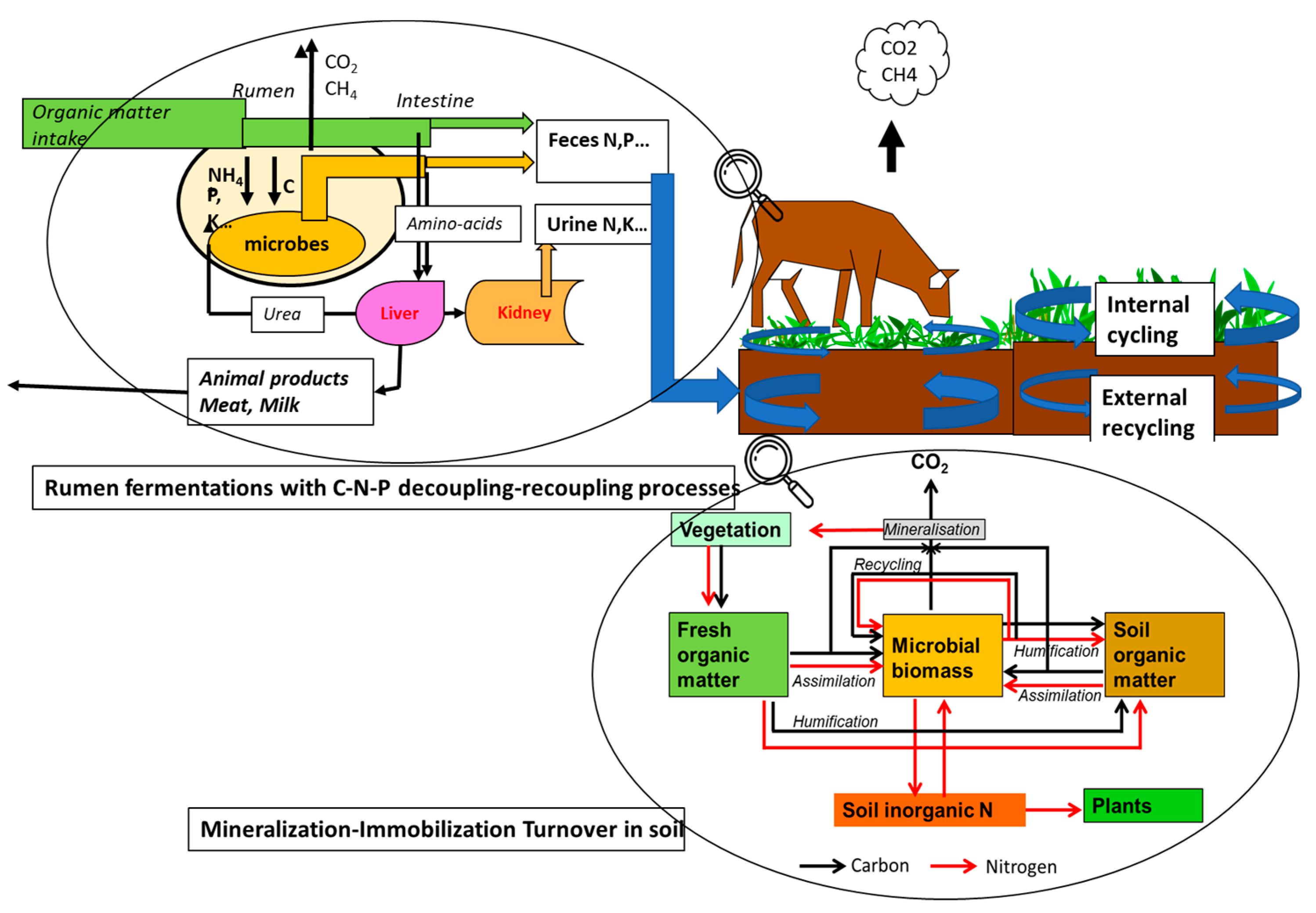
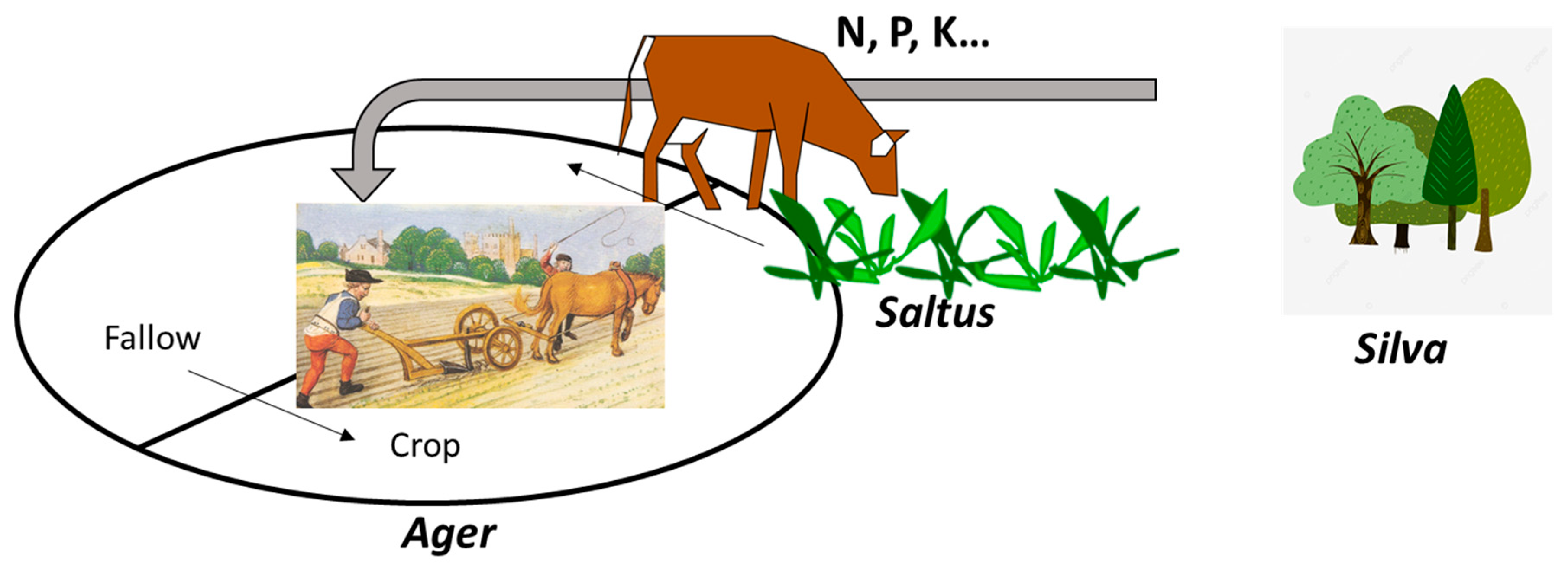
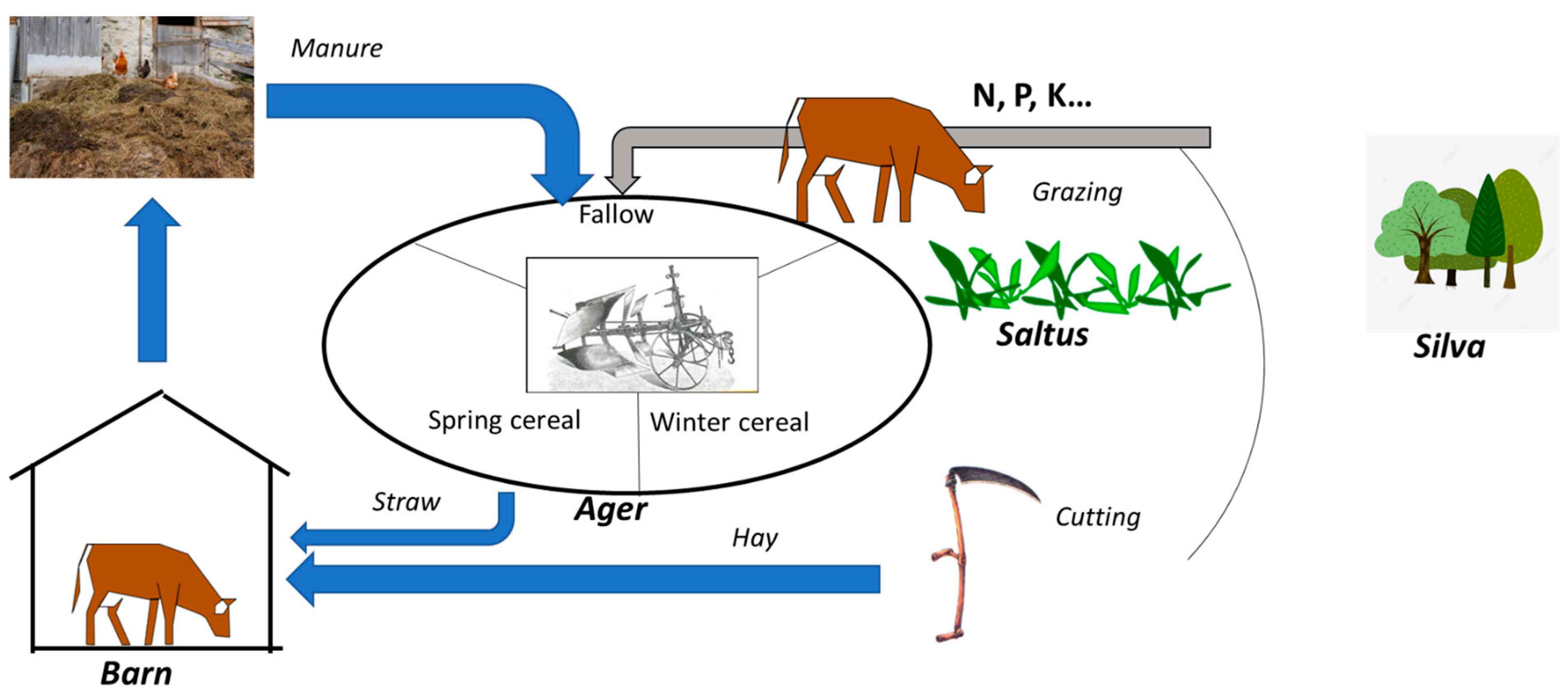
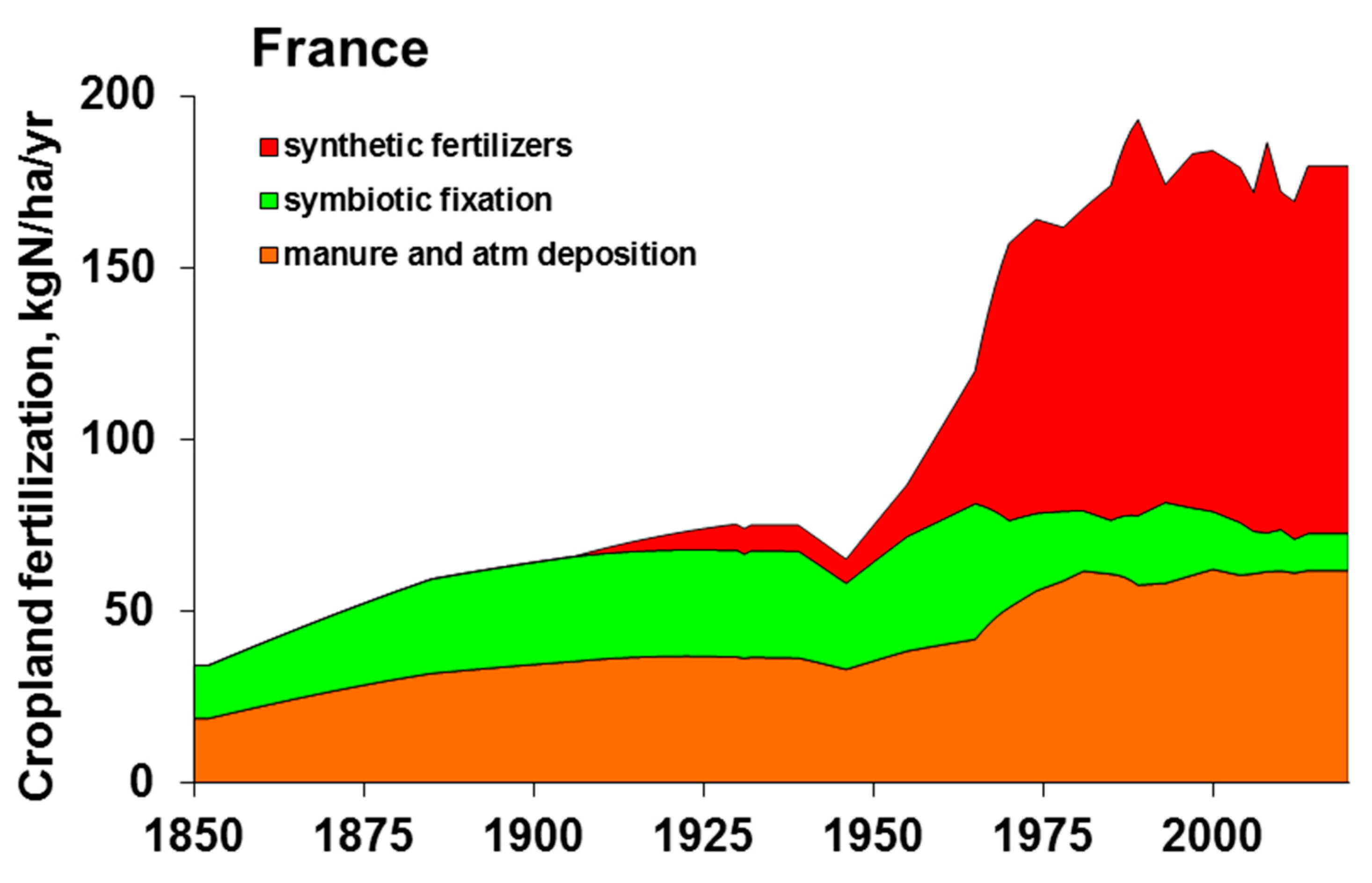
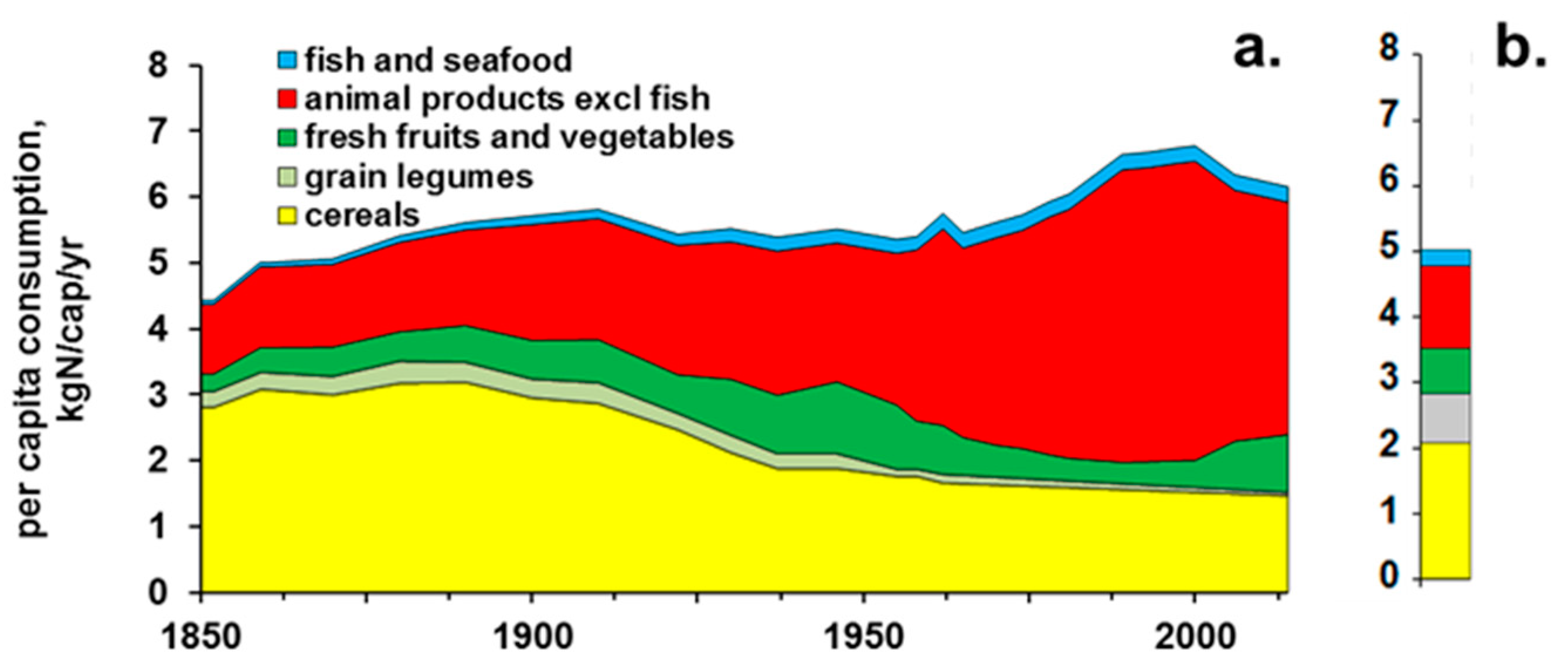
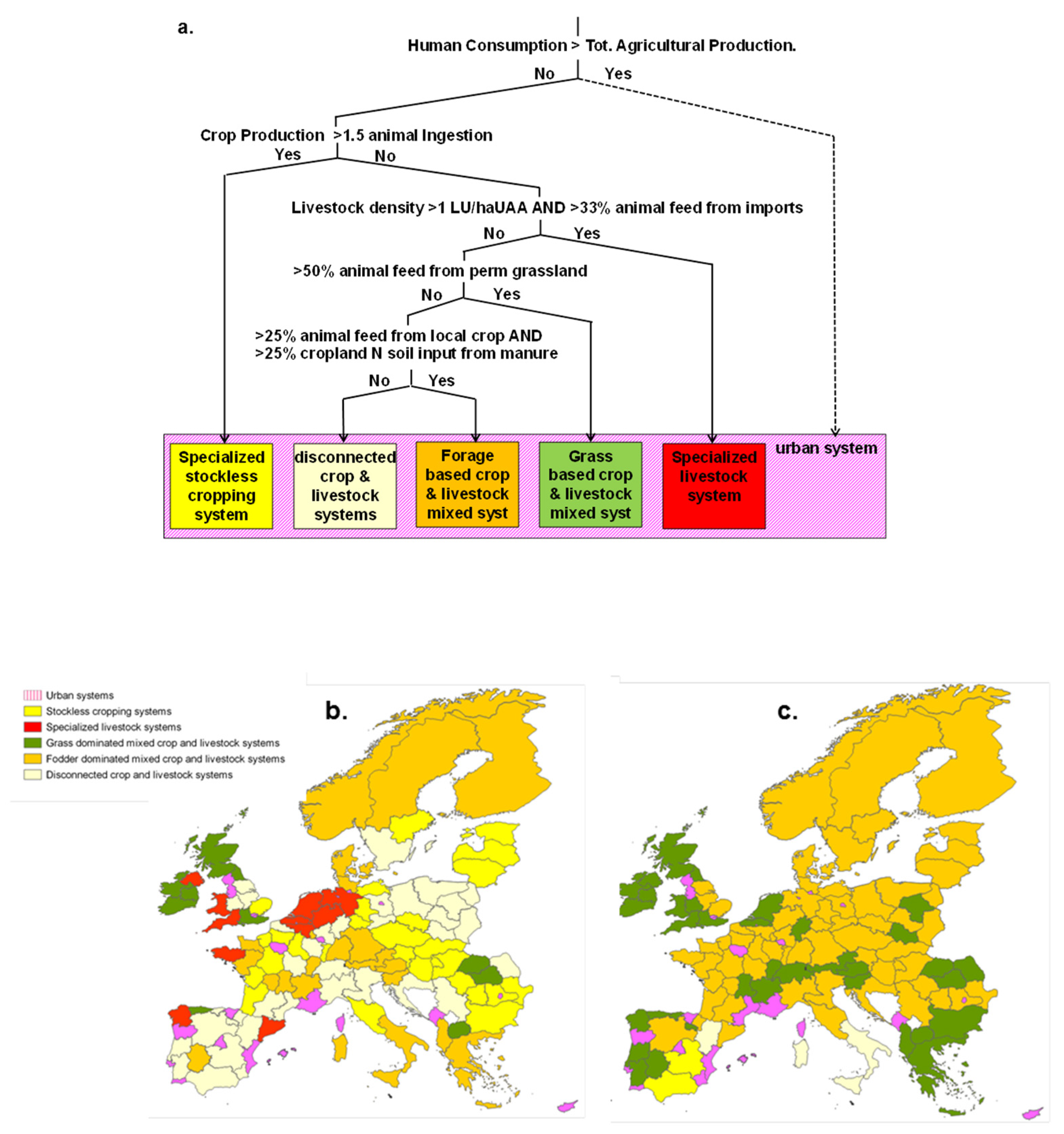
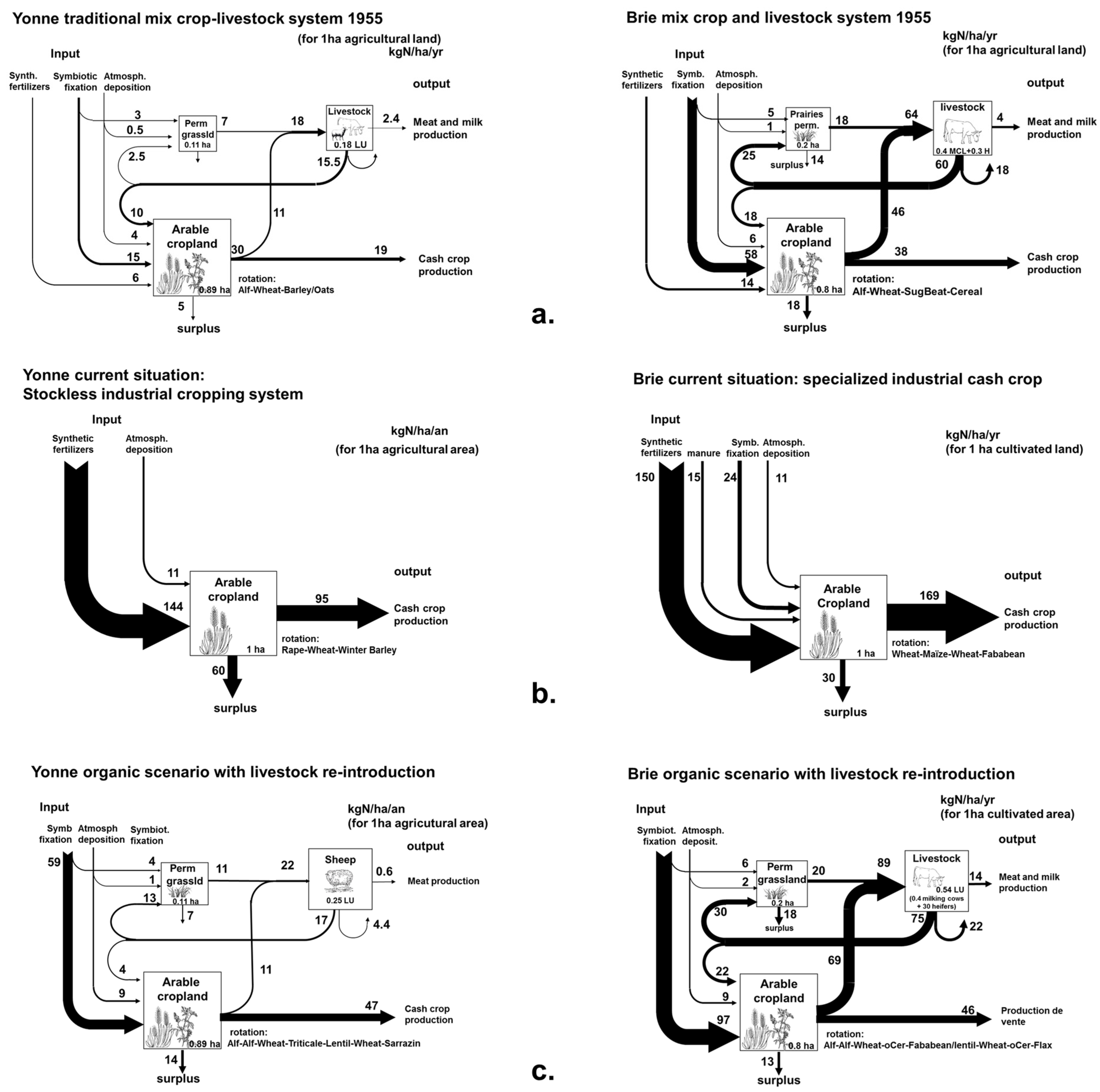
| a. Current situation (2014–2019) | ||||||
| Systems | Intensive specialized Livestock | Specialized Stockless Cropping | Disconnected Crop and Livestock | Fodder-Based Mix Crop and Livestock | Grass-Based Mixed Crop–Livestock | Total |
| Total area, Mha (%) | 16.4 (9%) | 48.9 (26%) | 65.5 (35%) | 38.0 (20%) | 16.9 (9%) | 185.8 |
| Vegetal prod, GgN/yr (%) | 564 (9%) | 2511 (38%) | 2165 (33%) | 1062 (16%) | 255 (4%) | 6556 |
| Animal food prod, GgN/yr (%) | 667 (30%) | 287 (13%) | 713 (32%) | 460 (21%) | 113 (5%) | 2240 |
| Synth fertilizer use, GgN/yr (%) | 1323 (11%) | 4214 (34%) | 4123 (34%) | 1852 (15%) | 756 (6%) | 12,267 |
| Losses to hydrosph, GgN/yr (%) | 1381 (17%) | 1892 (24%) | 2894 (36%) | 1361 (17%) | 484 (6%) | 8012 |
| Losses to atmosph, GgN/yr (%) | 670 (20%) | 665 (19%) | 1071 (31%) | 749 (22%) | 262 (8%) | 3416 |
| b. Agro-ecological scenario (2050) | ||||||
| Systems | Intensive specialized livestock | Specialized stockless cropping | Disconnected crop and livestock | Fodder-based mix crop and livestock | Grass-based mixed crop–livestock | Total |
| Total area, Mha (%) | - | 9.6 (5%) | 7.4 (4%) | 106.5 (57%) | 62.4 (34%) | 185.8 |
| Vegetal food prod., GgN/yr (%) | 53 (1%) | 81 (2%) | 3727 (77%) | 997 (21%) | 4858 | |
| Animal food prod, GgN/yr (%) | - | 7 (1%) | 17 (2%) | 706 (63%) | 387 (35%) | 1117 |
| Synth fertilizer use, GgN/yr (%) | - | - | - | - | - | - |
| Losses to hydrosph, GgN/yr (%) | 105 (3%) | 98 (3%) | 1942 (56%) | 1328 (38%) | 3473 | |
| Losses to atmosph, GgN/yr (%) | - | 16 (1%) | 30 (2%) | 1077 (62%) | 614 (35%) | 1735 |
Disclaimer/Publisher’s Note: The statements, opinions and data contained in all publications are solely those of the individual author(s) and contributor(s) and not of MDPI and/or the editor(s). MDPI and/or the editor(s) disclaim responsibility for any injury to people or property resulting from any ideas, methods, instructions or products referred to in the content. |
© 2023 by the authors. Licensee MDPI, Basel, Switzerland. This article is an open access article distributed under the terms and conditions of the Creative Commons Attribution (CC BY) license (https://creativecommons.org/licenses/by/4.0/).
Share and Cite
Lemaire, G.; Garnier, J.; da Silveira Pontes, L.; de Faccio Carvalho, P.C.; Billen, G.; Simioni Assmann, T. Domestic Herbivores, the Crucial Trophic Level for Sustainable Agriculture: Avenues for Reconnecting Livestock to Cropping Systems. Agronomy 2023, 13, 982. https://doi.org/10.3390/agronomy13040982
Lemaire G, Garnier J, da Silveira Pontes L, de Faccio Carvalho PC, Billen G, Simioni Assmann T. Domestic Herbivores, the Crucial Trophic Level for Sustainable Agriculture: Avenues for Reconnecting Livestock to Cropping Systems. Agronomy. 2023; 13(4):982. https://doi.org/10.3390/agronomy13040982
Chicago/Turabian StyleLemaire, Gilles, Josette Garnier, Laíse da Silveira Pontes, Paulo César de Faccio Carvalho, Gilles Billen, and Tangriani Simioni Assmann. 2023. "Domestic Herbivores, the Crucial Trophic Level for Sustainable Agriculture: Avenues for Reconnecting Livestock to Cropping Systems" Agronomy 13, no. 4: 982. https://doi.org/10.3390/agronomy13040982
APA StyleLemaire, G., Garnier, J., da Silveira Pontes, L., de Faccio Carvalho, P. C., Billen, G., & Simioni Assmann, T. (2023). Domestic Herbivores, the Crucial Trophic Level for Sustainable Agriculture: Avenues for Reconnecting Livestock to Cropping Systems. Agronomy, 13(4), 982. https://doi.org/10.3390/agronomy13040982








